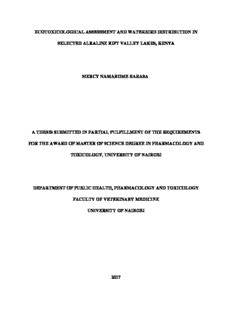
Ecotoxicological Assessment Andwaterbird Distribution In Selected Alkaline Rift Valley Lakes, Kenya PDF
Preview Ecotoxicological Assessment Andwaterbird Distribution In Selected Alkaline Rift Valley Lakes, Kenya
ECOTOXICOLOGICAL ASSESSMENT ANDWATERBIRD DISTRIBUTION IN SELECTED ALKALINE RIFT VALLEY LAKES, KENYA MERCY NAMAROME BARASA ATHESISSUBMITTED IN PARTIAL FULFILLMENT OFTHE REQUIREMENTS FORTHE AWARD OF MASTER OF SCIENCE DEGREE IN PHARMACOLOGY AND TOXICOLOGY, UNIVERSITY OF NAIROBI DEPARTMENT OF PUBLIC HEALTH, PHARMACOLOGY AND TOXICOLOGY FACULTY OF VETERINARY MEDICINE UNIVERSITY OF NAIROBI 2017 DECLARATION ii DEDICATION This work is dedicated to my lovely daughter Shantel, parents; David Barasa and Helen Wambaya, to my siblings Evans, Caren, Winnie and Brian and to my fiancé Patrick iii ACKNOWLEDGEMENT I express my sincere gratitude to my supervisors Prof. J. M. Mbaria, Dr. Gerald Muchemi and Dr. Francis Gakuya for their immense support, guidance and encouragement during the study and for their dedication towards ensuring that I complete my work in time. My appreciation also goes to the NACOSTI Kenya/South Africa bilateral project for funding my project. I also thank Mr. Wamiti and Dr. Edward Kariuki for their assistance and contribution during sample collection. My special thanks to the Chairman Department of Public health, Pharmacology and Toxicology, University of Nairobi for allowing me to use their laboratory facilities. My laboratory work could not have been successful without technical assistance and advice from Mr. F. K. Gitau, Mr. J. G. Nderitu, Mrs. L. Mwangi and Mr. K. Maloba, I am also indebted to the Ministry of Mining, Department of Mines and Geology for giving me a chance to use their facilities for heavy metal analysis through the assistance of Mr. Mwangi. I am also thankful to my colleagues Dr. Ogeto, Dr. Olubanda, Dr. Chebet, Dr. Saka and Mr. Mwendwa for their moral support and encouragement on academic issues. Above all, I thank the Almighty God for His Mercy and Grace upon my studies. Through Him, all things were successful despite a few difficulties. iv TABLE OF CONTENTS DECLARATION............................................................................................................................ii DEDICATION...............................................................................................................................iii ACKNOWLEDGEMENT.............................................................................................................iv TABLE OF CONTENTS................................................................................................................v LIST OF TABLES.......................................................................................................................viii LIST OF FIGURES.......................................................................................................................ix LIST OF APPENDICES.................................................................................................................x ABBREVIATIONS AND ACRONYMS......................................................................................xi ABSTRACT..................................................................................................................................xii CHAPTER ONE.............................................................................................................................1 INTRODUCTION..........................................................................................................................1 1.1 Background...........................................................................................................................1 1.2 General objective..................................................................................................................2 1.2.1 Specific Objectives.........................................................................................................2 1.3 Justification...........................................................................................................................2 CHAPTER TWO............................................................................................................................4 LITERATURE REVIEW...............................................................................................................4 2.1 Heavymetals.........................................................................................................................5 2.1.1 Mercury..........................................................................................................................5 2.1.2 Lead................................................................................................................................6 2.1.3 Cadmium........................................................................................................................6 2.1.4 Chromium.......................................................................................................................7 2.2 Other elements.......................................................................................................................7 v 2.2.1 Copper............................................................................................................................7 2.2.2 Zinc, Cobalt and Manganese..........................................................................................8 2.2.3 Analysis of metal elements.............................................................................................8 2.3 Importance of water birds...................................................................................................10 2.3.1 Role in biological invasion...........................................................................................10 2.3.2 Bio-monitors of the ecosystem health..........................................................................10 CHAPTER THREE......................................................................................................................12 MATERIALS AND METHODS..................................................................................................12 3.1 Study sites...........................................................................................................................12 3.2 Sample size determination and collection...........................................................................15 3.2.1 Sample size determination............................................................................................15 3.2.2 Samples collection........................................................................................................15 3.3 Laboratory analysis.............................................................................................................16 3.3.1 Water sample preparation for heavy metal analysis.....................................................16 3.3.2 Soil sediment sample preparation for heavy metal analysis.........................................16 3.3.3 Sample preparation for fluoride analysis......................................................................17 3.3.4 Analysis of heavy metals..............................................................................................17 3.3.5 Fluoride analysis...........................................................................................................18 3.4 Analysis of flamingo population trend................................................................................19 3.5 Water birds identification....................................................................................................19 3.6 Data management................................................................................................................19 CHAPTER FOUR.........................................................................................................................20 RESULTS.....................................................................................................................................20 vi 4.1 General findings for the lakes.............................................................................................20 4.1.1 Lake Oloiden................................................................................................................20 4.1.2 Crater Lake (Sonachi)...................................................................................................22 4.1.3 Lake Nakuru National Park..........................................................................................22 4.1.4 Lake Bogoria................................................................................................................22 4.1.5 Lake Magadi.................................................................................................................23 4.1.6 Lake Elementaita..........................................................................................................24 4.2 Fluoride analysis.................................................................................................................24 4.3 Results for Metal Elements analyzed by Atomic Absorption Spectroscopy......................28 4.4 Elements analyzed by X-ray Fluorescence (XRF)..............................................................30 4.5 Birds sighted at or around the lakes....................................................................................32 4.6 Waterbird families sighted and identified...........................................................................32 4.7 Water bird distribution in relation to metal concentration..................................................33 4.8 Kenya Rift Valley flamingo population trends...................................................................34 CHAPTER FIVE..........................................................................................................................41 DISCUSSION,CONCLUSION AND RECOMMENDATIONS................................................41 5.1 DISCUSSION.....................................................................................................................41 5.2 CONCLUSION...................................................................................................................45 5.3 RECOMMENDATIONS....................................................................................................46 REFERENCES.............................................................................................................................47 APPENDICES..............................................................................................................................52 vii LIST OF TABLES Table 4. 1: Mean fluoride concentrations in sediment and water samples (Mean ± SD) from the six Rift Valley Lakes, Kenya...............................................................................................25 Table 4. 2: The mean concentration (ppm) of sediment samples using Atomic Absorption Spectrometry........................................................................................................................28 Table 4. 3: Mean concentration (ppm) of water samples using Atomic Absorption Spectrometry ..............................................................................................................................................29 Table 4. 4: Maximum and minimum levels of sediment samples in ppm....................................29 Table 4. 5: Maximum and minimum levels in ppm of metal elements in watersamples .............30 Table 4.6: Mean concentration of metal elements (Ni, As, Hg and Pb) in ppm for the six Kenya Rift Valley Lakes.................................................................................................................31 Table 4.7: Water bird families identified at the Lakes..................................................................33 viii LIST OF FIGURES Figure 3. 1: Map of Rift Valley Alkaline Lakes in Kenya (Source: Barasa et al 2017)...............13 Figure 3. 2 : Author collecting water sample at Lake Nakuru......................................................15 Figure 3. 3: Author labeling samples before storage..................................................................16 Figure 3.4: Fluoride sediment standard curve...............................................................................18 Figure 3.5: Fluoride standard curve for water samples.................................................................18 Figure 4. 1: Tilapia fishing at Lake Oloiden.................................................................................21 Figure 4. 2: Water hyacinth (Eichornia crassipes) (arrow) at the shores of Lake Oloiden...........21 Figure 4. 3: The author and other team members assessing algal Bloom (arrow) at the shores of Lake Bogoria........................................................................................................................23 Figure 4. 4: Algal bloom (arrow) at the shores of Lake Bogoria.................................................23 Figure 4. 5: Water fluoride concentration (ppm) per lake...........................................................26 Figure 4. 6: Fluoride concentrations (ppm) in sediment samples for six Rift Valley lakes, Kenya ..............................................................................................................................................27 Figure 4. 7: Water birds density in lakes Nakuru, Magadi, Oloiden, Elementaita, Crater and Bogoria.................................................................................................................................32 Figure 4. 8: Figure showing flamingo population trends in Lake Oloiden...................................34 Figure 4. 9: Flamingo population trends in Lake Sonachi (Crater)..............................................35 Figure 4. 10: Flamingo population patterns in Lake Naivasha.....................................................36 Figure 4. 11: Figure showing flamingo population trends in Lake Bogoria.................................37 Figure 4. 12: Flamingo population trends in Lake Elementaita....................................................38 Figure 4. 13: Flamingo population trends in Lake Magadi ..........................................................39 Figure 4. 14: Flamingo population trends in Lake Nakuru...........................................................40 ix LIST OF APPENDICES Appendix 1: Concentration of fluoride in sediment samples from lakes Elementaita, Bogoria, Oloiden, Crater, Magadi and Nakuru.......................................................................52 Appendix 2: Fluoride concentration for water samples................................................................53 Appendix 3: Metal element concentrations (ppm) in sediments from Lakes Nakuru, Bogoria, Magadi, Crater, Oloiden and Elementaita analyzed by Atomic Absorption Spectrophotometry...................................................................................................55 Appendix 4: Metal element concentrations in water samples from Lakes Nakuru, Bogoria, Magadi, Crater, Oloiden and Elementaita analyzed by Atomic absorption spectrophotometry...................................................................................................56 Appendix 5: January and July annual flamingo counts from 1990 to 2015 in Lakes Oloiden, Sonachi, Naivasha, Nakuru, Magadi, Elementaita and Bogoria..............................58 Appendix 6: Birds sighted at or around the lakes.........................................................................60 x
Description: